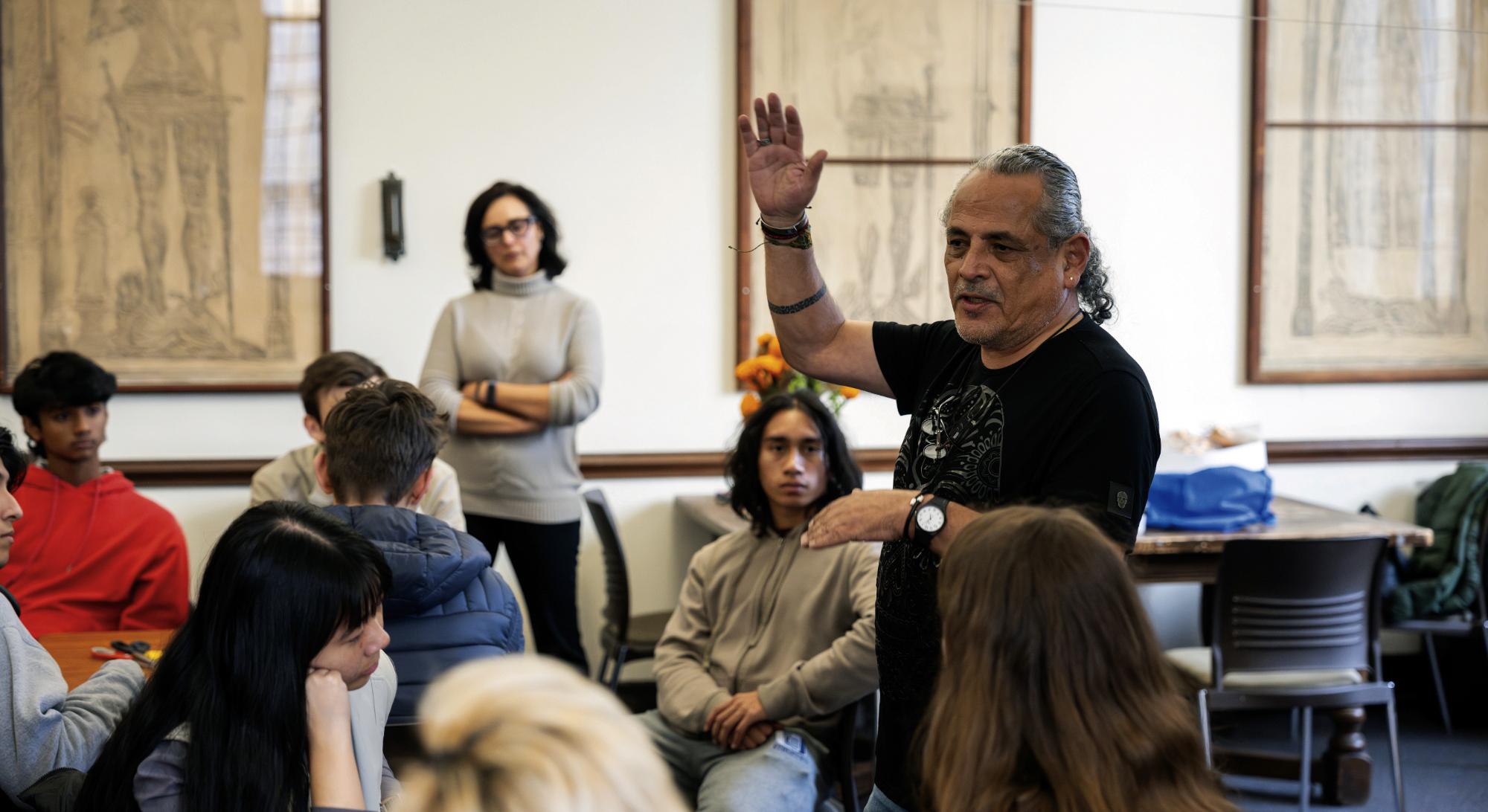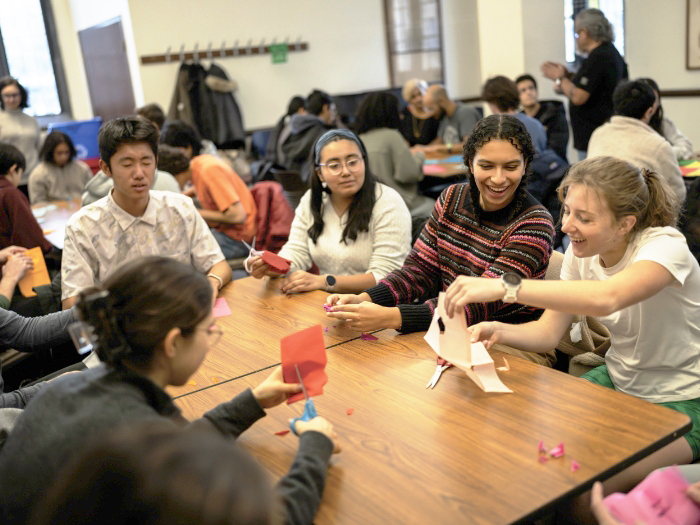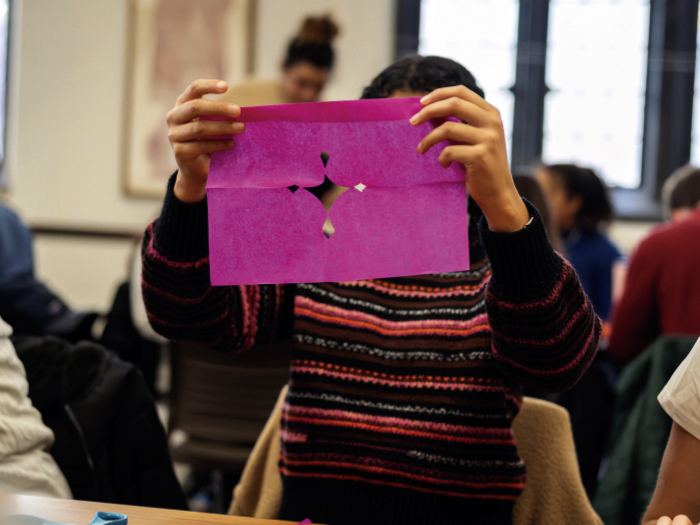
At a meeting of El Cafecito, Pilsen-based artist Ramón Marino explains, in Spanish, how to make traditional Day of the Dead crafts. (Photography by Jason Smith)
¡Papel picado, flores, y pan de muerto!
On the beautiful autumn afternoon of November 1—el Día de Muertos (the Day of the Dead)—about 60 Spanish-language students have clustered around long tables in Classics 110, one of its mullioned windows propped open to let in the crisp breeze.
It’s a meeting of El Cafecito, which translates loosely as “a chat over coffee,” the club organized by Verónica Moraga Guerra, AM’08, associate instructional professor of Spanish. Moraga invites different guests from the Spanish-speaking community to each meeting. UChicago students get to hear all kinds of accents—Paraguayan Spanish, Ecuadorian Spanish, Spanglish, and more—and pick up cultural knowledge.
Today’s guest is Ramón Marino, a Pilsen-based artist trained at Mexico City’s Instituto Nacional de Bellas Artes y Literatura (National Institute of Fine Arts and Literature). He’s wearing a black T-shirt embossed with a shiny black calavera (skull).
Students will craft two key elements of the ofrendas (altars) that Mexicans assemble to honor and commune with their ancestors. First they’ll make papel picado, brightly colored tissue paper pierced with elaborate cutouts. Then they’ll create flores de cempasúchil, paper flowers modeled on the brilliant orange marigolds placed on altars; their scent and color are said to guide the spirits as they roam among the living.
Speaking entirely in Spanish, Marino explains the significance of the crafts for “una tradición totalmente mexicana-azteca”: a Mexican tradition with deep Indigenous roots.
The students listen with serious, inscrutable expressions. It’s unclear how many of them are following along and how many are struggling.
“Bueno, son los cuatro elementos,” says Marino, naming the four elements of earth, air, fire, and water. He gestures to strings that he has hung between the room’s thick square columns. “El papel picado que se cuelga en hilos es lo que representa el viento”: the papel picado is strung so that it flaps in the breeze, signifying the air. The flowers signify the earth from which they spring.

Candles are placed on altars to represent fire, he says, along with glasses of water. “El agua también es muy importante porque vienen cansados los muertos y están esperando algo de tomar.” (The water is important because the spirits arrive tired from their journey, and they want something to drink.)
Marino pauses to joke that in Mexico, they often put out other beverages to entice los muertos to drink as well. Some students laugh—they get the joke.
Marino demonstrates the papel picado technique, cutting a bright green sheet with geometric patterns and hanging it to float on the line.
“¿Preguntas? ¿Preguntas?” (Questions? Questions?) he asks. He weaves through the crowded room—an obstacle course of knees, sneakers, and backpacks—providing assistance and commentary: “¡Bueno!” “¡Órale!” (Wow!) and, occasionally, “Nice!”
Most students revert immediately to English. One holds up a bright red papel picado for her friend to admire: “She’s cute, right? I love her!” At another table, a pair of friends do their best to stick with Spanish. “¡Mira!” says one as she displays her creation, “Look!” A few students are obviously fluent, including one who asks Marino about Latin American food traditions. The lines are soon strung with lilac, crimson, gold, and turquoise papers trembling in the breeze.

Next Marino shows how to make a paper flower. The students need to gather “seis hojas” (six sheets) of the gossamer-thin paper they’ll fold like accordions. He holds up the fuzzy green pipe cleaner that will become the stem and asks what it’s called: “¿Cómo se llama?”
Does he want the word for “stem” or “pipe cleaner”? No one hazards a guess.
“En inglés?” he presses.
“Pipe cleaner,” someone offers.
“Y en español?”
Silencio.
“¡Limpia pipa!” he exclaims. The students erupt in laughter at the easy answer. Even beginning Spanish speakers know the verb limpiar is “to clean,” while pipa is self-explanatory.
As he moves among them, he discovers a glitch in communication: at one table, students are trying to make flowers with a single thin sheet of paper. “¡Seis hojas! ¡Seis hojas!” he repeats.
“This takes patience,” a student exclaims. Heads bent over their bunched papers, the students struggle to separate the flower petals. “Sin miedo, es papel. Si se rompe, ¡ni modo!” Marino assures them. (Don’t be afraid. It’s just paper. So if it rips, no problem!)
Through a mixture of explanation and demonstration, everyone ends up catching on. Cheerful orange flowers begin to emerge.
As a few students prepare to leave, Moraga makes an announcement: There is pan de muerto to take on the way out—sweet bread made especially for the holiday, shaped to look as though bones are baked into it.
With that, the event abruptly ends. The students stampede toward the treats.
Updated 02.15.2024 to correct the spelling of Ramón Marino’s last name.
